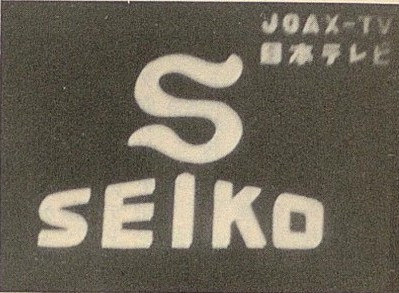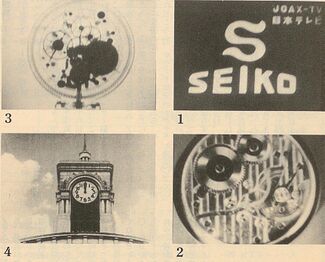Seiko's "first-aired" commercial (lost first Japanese commercial to be broadcasted on Japanese TV; 1953)
On August 28, 1953, NTV became the first commercial broadcaster in Japan. At 11:20 a.m., NTV's opening ceremony was broadcast live, followed at 11:50 a.m. by the celebratory dance performance Kotobuki Shiki Sanbasō (寿式三番叟). Then, from 11:59:30 to noon, K. Hattori (currently named Seiko) in Ginza, Tokyo, aired a 30-second commercial announcing noon. This is believed to be the first commercial aired in Japan. Furthermore, this commercial is considered Japan's first broadcast accident because it was aired reverse orientation.
Incorrect information of the Seiko first commercial
Seiko released the following video as "Japanese first TV commercial," but this is incorrect, the commercial was aired at 7:00 p.m. on the NTV's opening day of the station. Therefore, this is Seiko's second commercial.
Furthermore, Seiko explains in the description of this video that "the commercial was originally supposed to be broadcast at noon, but the film was hung upside down and the broadcast was stopped after only three seconds," a happening that was strongly denied by then Dentsu's managing director Toshio Naitō who was present at the opening of NTV.
As for the source of the story that the commercials stopped after three seconds, it appears to be a recollection by then advertising manager K. Hattori, Shunzaburō Katayama, published in Dentsuhō on April 19, 1961.
This first one turned out to be a disaster. The film was broadcast upside down. Of course, there was no sound. On the contrary, the sound part was flickering on the screen. I gasped. The person in charge must have been surprised. When the title "Seiko" appeared on the screen, the film broadcasting stopped. It lasted less than three seconds.
Although it is not yet clear which of Katayama's or Naitō's testimony is correct, since Naitō was on the scene when the station opened, it is likely that the theory that "Aired for 30 seconds in reverse orientation" is correct.
Incidentally, the video here is a commercial by Seiko to announce noon, but this is not the first commercial either, as it was aired on the 29th, the day after the station opened.
Availability
This commercial has been completely lost. In 1963, 10 years after NTV's opening, when producing a special program to commemorate the station's 10th anniversary, several films of representative early commercials were borrowed from Dentsu, but after the program went on the air, the program staff destroyed all the films. These included the Seiko commercials. The reason why they were destroyed is unknown, and Naitō said that he greatly regretted this tragedy.
The only copies that exist are four captures of the commercials that appeared in the 25-Year History of Commercial (CM25年史) published in 1978.
Transcription
The 25-Year History of Commercial also includes a transcript of the commercial.
A watch rotates 5 times per second, or 432,000 times during the day and night. It should be disassembled and cleaned at least once a year. The Seikosha clock announces noon.
Other candidate for the first commercial
Kōhei Kōno, a professor at Ibaraki University's College of Humanities and Social Sciences, called into question the theory that this Seiko commercial was the first, and gave other possible candidates for the first commercial.
Kotobuki Shiki Sanbasō, which aired before the Seiko commercial, was sponsored by Toshiba, and Kōno stated that since Toshiba sponsored the program, it was natural to assume that they had some kind of commercial when the program aired, even if it did not use visual representation. He stated that if the announcer said a line in the program that used advertising, it was a commercial and should be considered the first commercial in Japan.
However, we cannot verify the footage of Kotobuki Shiki Sanbasō and therefore do not know if the commercial existed or not. Therefore, Kōno stated that the Seiko commercial was tentatively the first Japanese commercial.
References
- Blog post by Kōhei Kōno - note Retrieved May 20, 2023

